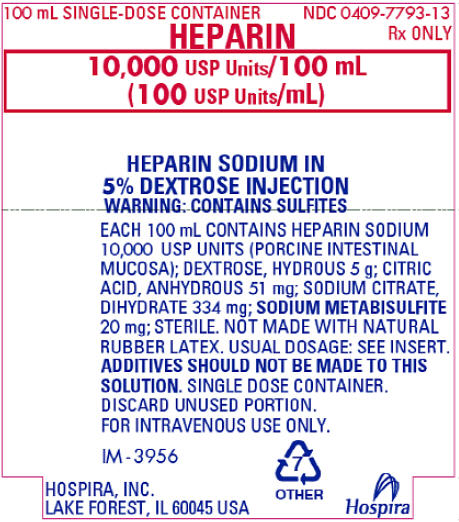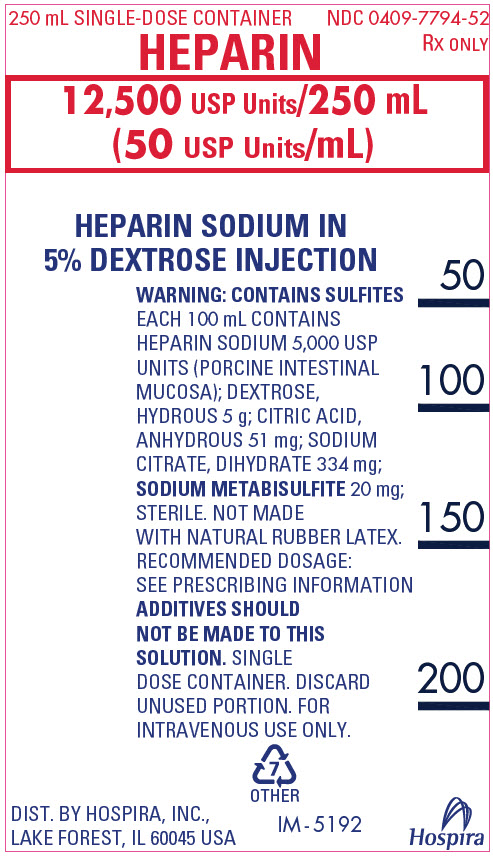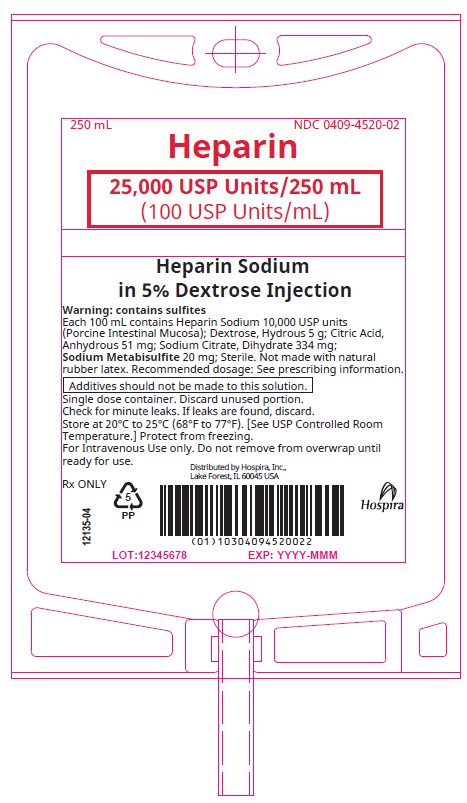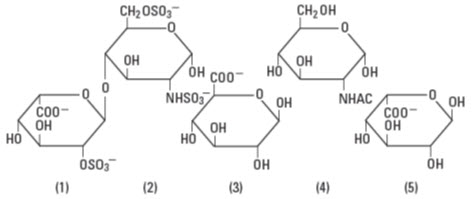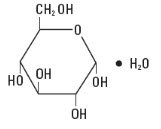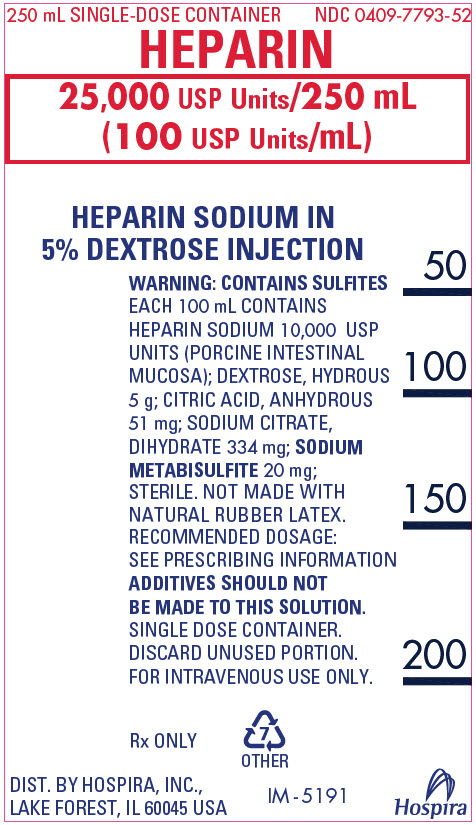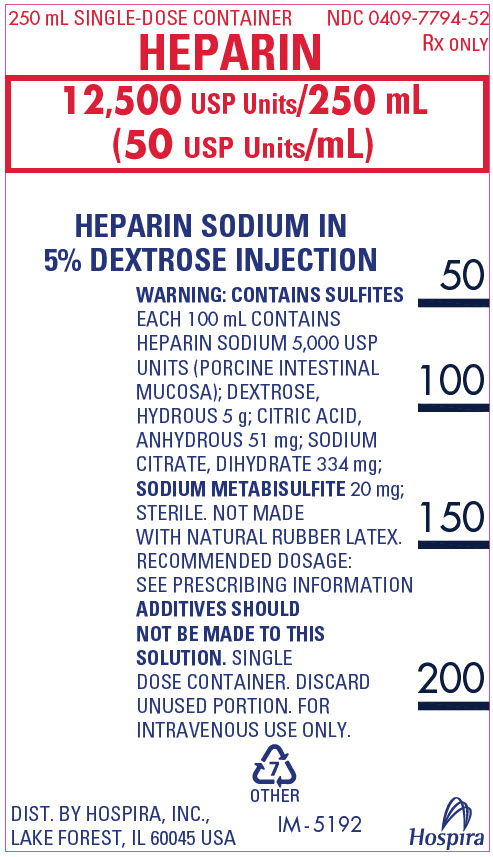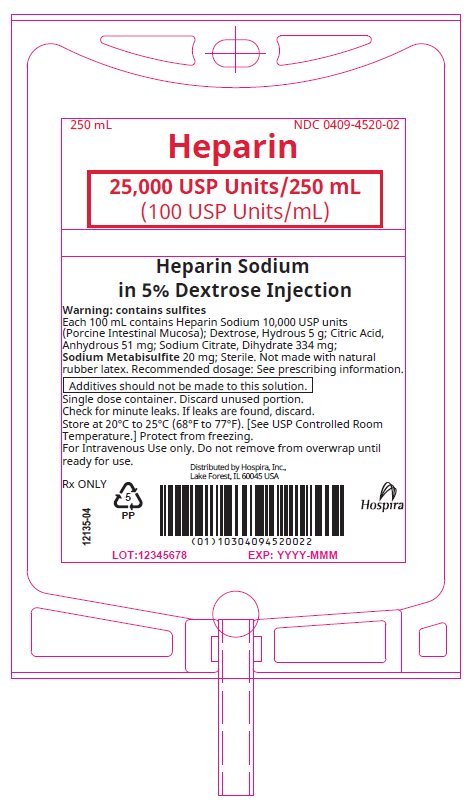Label: HEPARIN SODIUM AND DEXTROSE- heparin sodium injection, solution
-
NDC Code(s):
0409-4520-02,
0409-4520-30,
0409-7793-13,
0409-7793-23, view more0409-7793-52, 0409-7793-62, 0409-7794-52, 0409-7794-62
- Packager: Hospira, Inc.
- Category: HUMAN PRESCRIPTION DRUG LABEL
- DEA Schedule: None
- Marketing Status: New Drug Application
Drug Label Information
Updated March 26, 2024
If you are a consumer or patient please visit this version.
- Download DRUG LABEL INFO: PDF XML
- Official Label (Printer Friendly)
-
HIGHLIGHTS OF PRESCRIBING INFORMATION
These highlights do not include all the information needed to use HEPARIN SODIUM IN 5% DEXTROSE INJECTION safely and effectively. See full prescribing information for HEPARIN SODIUM IN 5% DEXTROSE INJECTION.
HEPARIN SODIUM IN 5% DEXTROSE INJECTION, for intravenous use
Initial U.S. Approval: 1939RECENT MAJOR CHANGES
Contraindications (4)
12/2023
Warnings and Precautions, Hemorrhage (5.2)
12/2023
Warnings and Precautions, Heparin-Induced Thrombocytopenia (HIT) and Heparin-Induced Thrombocytopenia and Thrombosis (HITT) (5.3)
12/2023
Warnings and Precautions, Hypersensitivity Reactions (5.7)
12/2023
Warnings and Precautions, Hyperkalemia (5.8)
12/2023
Warnings and Precautions, Elevations of Serum Aminotransferases (5.9)
12/2023
INDICATIONS AND USAGE
Heparin Sodium in 5% Dextrose Injection is indicated for: (1)
- •
- Prophylaxis and treatment of venous thrombosis and pulmonary embolism.
- •
- Prophylaxis and treatment of thromboembolic complications associated with atrial fibrillation.
- •
- Treatment of acute and chronic consumption coagulopathies (disseminated intravascular coagulation).
- •
- Prevention of clotting in arterial and cardiac surgery.
- •
- Prophylaxis and treatment of peripheral arterial embolism.
- •
- Anticoagulant use in blood transfusions, extracorporeal circulation and dialysis procedures.
DOSAGE AND ADMINISTRATION
Recommended Adult Dosages:
- •
- Therapeutic Anticoagulant Effect with Full-Dose Heparin* (2.3)
Intermittent Intravenous Injection
Initial Dose
10,000 Units, either undiluted or in 50 to 100 mL of 5% Dextrose Injection
Subsequent Doses
5,000 to 10,000 Units every 4 to 6 hours, either undiluted or in 50 to 100 mL of 5% Dextrose Injection
Continuous Intravenous Infusion
Initial Dose
5,000 Units by intravenous injection
Continuous
20,000 to 40,000 Units every 24 hours in 1000 mL of 5% Dextrose Injection
*Based on 150 lb. (68 kg) patient.
- •
- Cardiovascular Surgery (2.5)
Intravascular via Total Body Perfusion
Initial Dose
Greater than or equal to 150 units/kg; adjust for longer procedures
- •
- Extracorporeal Dialysis (2.8)
Intravascular via Extracorporeal Dialysis
Follow equipment manufacturer's operating directions carefully.
For pediatric dosing see section 2.4 of full prescribing information.
DOSAGE FORMS AND STRENGTHS
CONTRAINDICATIONS
- •
- History of heparin-induced thrombocytopenia (HIT) or heparin-induced thrombocytopenia and thrombosis (HITT). (4)
- •
- Known hypersensitivity to heparin or pork products. (4)
- •
- In whom suitable blood coagulation tests cannot be performed at appropriate intervals. (4)
- •
- Uncontrollable active bleeding state, except when this is due to disseminated intravascular coagulation. (4)
WARNINGS AND PRECAUTIONS
- •
- Fatal Medication Errors: Confirm choice of correct strength prior to administration. (5.1)
- •
- Hemorrhage: Fatal cases have occurred. Monitor for signs of bleeding and manage promptly. (5.2)
- •
- HIT or HITT: Monitor for signs and symptoms and discontinue if indicative of HIT or HITT. (5.3)
- •
- Thrombocytopenia: Monitor platelet count during therapy; discontinue heparin if HIT or HITT is suspected. (5.4)
- •
- Monitoring: Blood coagulation tests guide therapy for full-dose heparin. Monitor platelet count and hematocrit in all patients receiving heparin. (5.5)
- •
- Heparin Resistance: Increased resistance to heparin is frequently encountered in fever, thrombosis, thrombophlebitis, infections with thrombosing tendencies, myocardial infarction, cancer and in postsurgical patients. (5.6)
- •
- Hypersensitivity Reactions: Use in patients with prior reactions only in life-threatening situations. (5.7)
- •
- Hyperkalemia: Measure plasma potassium in patients at risk of hyperkalemia before starting heparin therapy and periodically in all patients. (5.8)
- •
- Elevations of Serum Aminotransferases: Interpret elevation of these enzymes with caution. (5.9)
ADVERSE REACTIONS
Most common adverse reactions are: hemorrhage, thrombocytopenia, HIT or HITT, heparin resistance, hypersensitivity reactions, hyperkalemia, and elevations of aminotransferase levels. (6)
To report SUSPECTED ADVERSE REACTIONS, contact Pfizer Inc at 1-800-438-1985 or FDA at 1-800-FDA-1088 or www.fda.gov/medwatch.
DRUG INTERACTIONS
Drugs that interfere with coagulation, platelet aggregation or drugs that counteract coagulation may induce bleeding. (7)
See 17 for PATIENT COUNSELING INFORMATION.
Revised: 12/2023
-
Table of Contents
FULL PRESCRIBING INFORMATION: CONTENTS*
1 INDICATIONS AND USAGE
2 DOSAGE AND ADMINISTRATION
2.1 Preparation for Administration
2.2 Laboratory Monitoring for Efficacy and Safety
2.3 Therapeutic Anticoagulant Effect with Full-Dose Heparin
2.4 Pediatric Use
2.5 Cardiovascular Surgery
2.6 Converting to Warfarin
2.7 Converting to Oral Anticoagulants other than Warfarin
2.8 Extracorporeal Dialysis
3 DOSAGE FORMS AND STRENGTHS
4 CONTRAINDICATIONS
5 WARNINGS AND PRECAUTIONS
5.1 Fatal Medication Errors
5.2 Hemorrhage
5.3 Heparin-Induced Thrombocytopenia (HIT) and Heparin-Induced Thrombocytopenia and Thrombosis (HITT)
5.4 Thrombocytopenia
5.5 Coagulation Testing and Monitoring
5.6 Heparin Resistance
5.7 Hypersensitivity Reactions
5.8 Hyperkalemia
5.9 Elevations of Serum Aminotransferases
6 ADVERSE REACTIONS
6.1 Postmarketing Experience
7 DRUG INTERACTIONS
7.1 Oral Anticoagulants
7.2 Platelet Inhibitors
7.3 Other Medications that May Interfere with Heparin
8 USE IN SPECIFIC POPULATIONS
8.1 Pregnancy
8.2 Lactation
8.4 Pediatric Use
8.5 Geriatric Use
10 OVERDOSAGE
11 DESCRIPTION
12 CLINICAL PHARMACOLOGY
12.1 Mechanism of Action
12.2 Pharmacodynamics
12.3 Pharmacokinetics
13 NONCLINICAL TOXICOLOGY
13.1 Carcinogenesis, Mutagenesis, Impairment of Fertility
16 HOW SUPPLIED/STORAGE AND HANDLING
17 PATIENT COUNSELING INFORMATION
- *
- Sections or subsections omitted from the full prescribing information are not listed.
-
1 INDICATIONS AND USAGE
Heparin Sodium in 5% Dextrose Injection is indicated for:
- •
- Prophylaxis and treatment of venous thrombosis and pulmonary embolism
- •
- Prophylaxis and treatment of thromboembolic complications associated with atrial fibrillation
- •
- Treatment of acute and chronic consumption coagulopathies (disseminated intravascular coagulation)
- •
- Prevention of clotting in arterial and cardiac surgery
- •
- Prophylaxis and treatment of peripheral arterial embolism
- •
- Anticoagulant use in blood transfusions, extracorporeal circulation, and dialysis procedures.
-
2 DOSAGE AND ADMINISTRATION
2.1 Preparation for Administration
Confirm the selection of the correct formulation and strength prior to administration of the drug.
This product should be administered by intravenous infusion.
Do not use Heparin Sodium in 5% Dextrose Injection as a “catheter lock flush” product.
Do not admix with other drugs.
Discard unused portion.
Do not use plastic containers in series connection.
This product should not be infused under pressure.
Parenteral drug products should be inspected visually for particulate matter and discoloration prior to administration, whenever solution and container permit. Use only if solution is clear and container and seals are intact.
To Open
Tear outer wrap and remove solution container.(Use aseptic technique)
- 1.
- Close flow control clamp of administration set.
- 2.
- Remove cover from outlet port at bottom of container.
- 3.
- Insert piercing pin of administration set into port with a twisting motion until the set is firmly seated.
NOTE: See full directions on administration set carton. - 4.
- Suspend container from hanger.
- 5.
- Squeeze and release drip chamber to establish proper fluid level in chamber.
- 6.
- Open flow control clamp and clear air from set. Close clamp.
- 7.
- Attach set to venipuncture device. If device is not indwelling, prime and make venipuncture.
- 8.
- Regulate rate of administration with flow control clamp.
Warning: Do not use flexible container in series connections.
2.2 Laboratory Monitoring for Efficacy and Safety
Adjust the dosage of heparin sodium according to the patient's coagulation test results. When heparin is given by continuous intravenous infusion, determine the coagulation time approximately every 4 hours in the early stages of treatment. When the drug is administered intermittently by intravenous injection, perform coagulation tests before each injection during the early stages of treatment and at appropriate intervals thereafter. Dosage is considered adequate when the activated partial thromboplastin time (APTT) is 1.5 to 2 times the normal or when the whole blood clotting time is elevated approximately 2.5 to 3 times the control value.
Periodic platelet counts, hematocrits, and tests for occult blood in stool are recommended during the entire course of heparin therapy.
2.3 Therapeutic Anticoagulant Effect with Full-Dose Heparin
The dosing recommendations in Table 1 are based on clinical experience. Although dosage must be adjusted for the individual patient according to the results of suitable laboratory tests, the following dosage schedules may be used as guidelines:
Table 1: Recommended Adult Full-Dose Heparin Regimens for Therapeutic Anticoagulant Effect Method of Administration Frequency Recommended Dose* - *
- Based on 150 lb. (68 kg) patient.
Intermittent Intravenous Injection
Initial Dose
10,000 Units, either undiluted or in 50 to 100 mL of 5% Dextrose Injection
Subsequent Doses
5,000 to 10,000 Units every 4 to 6 hours, either undiluted or in 50 to 100 mL of 5% Dextrose Injection
Continuous Intravenous Infusion
Initial Dose
5,000 Units by intravenous injection
Continuous
20,000 to 40,000 Units every 24 hours in 1,000 mL of 5% Dextrose Injection
2.4 Pediatric Use
There are no adequate and well-controlled studies on heparin use in pediatric patients. Pediatric dosing recommendations are based on clinical experience. In general, the following dosage schedule may be used as a guideline in pediatric patients:
Initial Dose
75 units/kg to 100 units/kg (intravenous bolus over 10 minutes)
Maintenance Dose
Infants: 25 units/kg/hour to 30 units/kg/hour;
Infants < 2 months have the highest requirements (average 28 units/kg/hour)
Children > 1 year of age: 18 units/kg/hour to 20 units/kg/hour;
Older children may require less heparin, similar to weight-adjusted adult dosageMonitoring
Adjust heparin to maintain APTT of 60 to 85 seconds, assuming this reflects an anti-Factor Xa level of 0.35 to 0.70.
2.5 Cardiovascular Surgery
Patients undergoing total body perfusion for open-heart surgery should receive an initial dose of not less than 150 units of heparin sodium per kilogram of body weight. Frequently, a dose of 300 units per kilogram is used for procedures estimated to last less than 60 minutes or 400 units per kilogram for those estimated to last longer than 60 minutes.
2.6 Converting to Warfarin
To ensure continuous anticoagulation when converting from heparin sodium to warfarin, continue full heparin therapy for several days until the INR (prothrombin time) has reached a stable therapeutic range. Heparin therapy may then be discontinued without tapering [see Drug Interactions (7.1)].
2.7 Converting to Oral Anticoagulants other than Warfarin
For patients currently receiving intravenous heparin, stop intravenous infusion of heparin sodium immediately after administering the first dose of oral anticoagulant; or for intermittent intravenous administration of heparin sodium, start oral anticoagulant 0 to 2 hours before the time that the next dose of heparin was to have been administered.
-
3 DOSAGE FORMS AND STRENGTHS
Heparin Sodium in 5% Dextrose Injection is available as:
- •
- Heparin Sodium 25,000 USP units per 250 mL (100 USP units per mL) in 5% Dextrose Injection.
- •
- Heparin Sodium 10,000 USP units per 100 mL (100 USP units per mL) in 5% Dextrose Injection.
- •
- Heparin Sodium 12,500 USP units per 250 mL (50 USP units per mL) in 5% Dextrose Injection.
-
4 CONTRAINDICATIONS
The use of Heparin Sodium in 5% Dextrose Injection is contraindicated in patients with the following conditions:
- •
- History of heparin-induced thrombocytopenia (HIT) and heparin-induced thrombocytopenia and thrombosis (HITT) [see Warnings and Precautions (5.3)]
- •
- Known hypersensitivity to heparin or pork products (e.g., anaphylactoid reactions) [see Warnings and Precautions (5.7), Adverse Reactions (6.1)]
- •
- In whom suitable blood coagulation tests — e.g., the whole blood clotting time, partial thromboplastin time, etc., — cannot be performed at appropriate intervals (this contraindication refers to full-dose heparin; there is usually no need to monitor coagulation parameters in patients receiving low-dose heparin) [see Warnings and Precautions (5.5)]
- •
- Uncontrollable active bleeding state except when this is due to disseminated intravascular coagulation [see Warnings and Precautions (5.2)].
-
5 WARNINGS AND PRECAUTIONS
5.1 Fatal Medication Errors
Do not use this product as a "catheter lock flush" product. Heparin is supplied in various strengths. Fatal hemorrhages have occurred due to medication errors. Carefully examine all heparin products to confirm the correct container choice prior to administration of the drug.
5.2 Hemorrhage
Hemorrhage, including fatal events, has occurred in patients receiving heparin sodium. Avoid using heparin in the presence of major bleeding, except when the benefits of heparin therapy outweigh the potential risks.
Hemorrhage can occur at virtually any site in patients receiving heparin. Adrenal hemorrhage (with resultant acute adrenal insufficiency), ovarian hemorrhage, and retroperitoneal hemorrhage have occurred during anticoagulant therapy with heparin [see Adverse Reactions (6.1)]. A higher incidence of bleeding has been reported in patients, particularly women, over 60 years of age [see Clinical Pharmacology (12.3)]. An unexplained fall in hematocrit or fall in blood pressure should lead to serious consideration of a hemorrhagic event.
Use heparin sodium with caution in disease states in which there is increased risk of hemorrhage, including:
- •
- Cardiovascular — Subacute bacterial endocarditis. Severe hypertension.
- •
- Surgical — During and immediately following (a) spinal tap or spinal anesthesia or (b) major surgery, especially involving the brain, spinal cord or eye.
- •
- Hematologic — Conditions associated with increased bleeding tendencies, such as hemophilia, thrombocytopenia and some vascular purpuras.
- •
- Patients with hereditary antithrombin III deficiency receiving concurrent antithrombin III therapy – The anticoagulant effect of heparin is enhanced by concurrent treatment with antithrombin III (human) in patients with hereditary antithrombin III deficiency. To reduce the risk of bleeding, reduce the heparin dose during concomitant treatment with antithrombin III (human).
- •
- Gastrointestinal — Ulcerative lesions and continuous tube drainage of the stomach or small intestine.
- •
- Other — Menstruation, liver disease with impaired hemostasis.
5.3 Heparin-Induced Thrombocytopenia (HIT) and Heparin-Induced Thrombocytopenia and Thrombosis (HITT)
HIT is a serious immune-mediated reaction resulting from irreversible aggregation of platelets. HIT occurs in patients treated with heparin and is due to the development of antibodies to a platelet Factor 4-heparin complex that induce in vivo platelet aggregation. HIT may progress to the development of venous and arterial thromboses, a condition known as HITT. Thrombotic events may also be the initial presentation for HIT. These serious thromboembolic events include deep vein thrombosis, pulmonary embolism, cerebral vein thrombosis, limb ischemia, stroke, myocardial infarction, thrombus formation on a prosthetic cardiac valve, mesenteric thrombosis, renal arterial thrombosis, skin necrosis, gangrene of the extremities that may lead to amputation, and possibly death.
Once HIT or HITT is diagnosed or strongly suspected, discontinue all heparin sources (including heparin flushes) and use an alternative anticoagulant.
Immune-mediated HIT is diagnosed based on clinical findings supplemented by laboratory tests confirming the presence of antibodies to heparin, or platelet activation induced by heparin. Obtain platelet counts at baseline and periodically during heparin administration. A drop in platelet count greater than 50% from baseline is considered indicative of HIT. Platelet counts begin to fall 5 to 10 days after exposure to heparin in heparin-naïve individuals and reach a threshold by days 7 to 14. In contrast, “rapid onset” HIT can occur very quickly (within 24 hours following heparin initiation), especially in patients with a recent exposure to heparin (i.e., previous 3 months).
Thrombosis development shortly after documenting thrombocytopenia is a characteristic finding in almost half of all patients with HIT.
Monitor thrombocytopenia of any degree closely. If the platelet count falls below 100,000/mm3 or if recurrent thrombosis develops, promptly discontinue heparin, evaluate for HIT and HITT, and, if necessary, administer an alternative anticoagulant.
HIT or HITT can occur up to several weeks after the discontinuation of heparin therapy. Patients presenting with thrombocytopenia or thrombosis after discontinuation of heparin should be evaluated for HIT or HITT.
5.4 Thrombocytopenia
Thrombocytopenia has been reported to occur in patients receiving heparin with a reported incidence of up to 30%. It can occur 2 to 20 days (average 5 to 9) following the onset of heparin therapy. Obtain platelet counts before and periodically during heparin therapy. Monitor thrombocytopenia of any degree closely. If the count falls below 100,000/mm3 or if recurrent thrombosis develops, promptly discontinue heparin, evaluate for HIT, and, if necessary, administer an alternative anticoagulant [see Warnings and Precautions (5.3)].
5.5 Coagulation Testing and Monitoring
When using a full dose heparin regimen, adjust the heparin dose based on frequent blood coagulation tests. If the coagulation test is unduly prolonged or if hemorrhage occurs, heparin sodium should be discontinued promptly [see Overdosage (10)]. Periodic platelet counts, hematocrits and tests for occult blood in stool are recommended during the entire course of heparin therapy [see Dosage and Administration (2.2)].
5.6 Heparin Resistance
Increased resistance to heparin is frequently encountered in fever, thrombosis, thrombophlebitis, infections with thrombosing tendencies, myocardial infarction, cancer and in postsurgical patients, and patients with antithrombin III deficiency.
Consider measurement of anti-thrombin levels if heparin resistance is suspected. Monitor coagulation tests frequently in such patients. It may be necessary to adjust the dose of heparin based on coagulation test monitoring, such as anti-Factor Xa levels and/or partial thromboplastin time.
5.7 Hypersensitivity Reactions
Hypersensitivity reactions with chills, fever and urticaria as the most usual manifestations and also asthma, rhinitis, lacrimation, and anaphylactoid reactions have been reported. Patients with documented hypersensitivity to heparin should be given the drug only in clearly life-threatening situations [see Adverse Reactions (6.1)].
Because Heparin Sodium in 5% Dextrose Injection is derived from animal tissue, monitor for signs and symptoms of hypersensitivity when it is used in patients with a history of allergy to pork products.
This product contains sodium metabisulfite, a sulfite that may cause allergic-type reactions including anaphylactic symptoms and life-threatening or less severe asthmatic episodes in certain susceptible people. The overall prevalence of sulfite sensitivity in the general population is unknown and probably low. Sulfite sensitivity is seen more frequently in asthmatic than in nonasthmatic people.
5.8 Hyperkalemia
Heparin can suppress adrenal secretion of aldosterone leading to hyperkalemia, particularly in patients with diabetes mellitus, chronic renal failure, pre-existing metabolic acidosis, a raised plasma potassium, or taking potassium sparing drugs. The risk of hyperkalemia appears to increase with duration of therapy but is usually reversible upon discontinuation of heparin.
Measure plasma potassium in patients at risk of hyperkalemia before starting heparin therapy and periodically in all patients treated for more than 5 days or earlier as deemed fit by the clinician.
5.9 Elevations of Serum Aminotransferases
Significant elevations of aspartate aminotransferase (AST) and alanine aminotransferase (ALT) levels have occurred in patients who have received heparin. Elevation of these enzymes in patients receiving heparin should be interpreted with caution. These elevations typically resolve upon heparin discontinuation.
-
6 ADVERSE REACTIONS
The following serious adverse reactions are described elsewhere in the labeling:
- •
- Hemorrhage [see Warnings and Precautions (5.2)]
- •
- Heparin-Induced Thrombocytopenia and Heparin-Induced Thrombocytopenia with Thrombosis [see Warnings and Precautions (5.3)]
- •
- Thrombocytopenia [see Warnings and Precautions (5.4)]
- •
- Heparin Resistance [see Warnings and Precautions (5.6)]
- •
- Hypersensitivity [see Warnings and Precautions (5.7)]
- •
- Hyperkalemia [see Warnings and Precautions (5.8)]
- •
- Elevations of Serum Aminotransferases [see Warnings and Precautions (5.9)]
6.1 Postmarketing Experience
The following adverse reactions have been identified during post-approval use of heparin sodium. Because these reactions are reported voluntarily from a population of uncertain size, it is not always possible to reliably estimate their frequency.
- •
- Hemorrhage - Hemorrhage is the chief complication that may result from heparin therapy [see Warnings and Precautions (5.2)]. An overly prolonged clotting time or minor bleeding during therapy can usually be controlled by withdrawing the drug [see Overdosage (10)]. Gastrointestinal or urinary tract bleeding during anticoagulant therapy may indicate the presence of an underlying occult lesion. Bleeding can occur at any site but certain specific hemorrhagic complications may be difficult to detect:
- a.
- Adrenal hemorrhage, with resultant acute adrenal insufficiency, has occurred with heparin therapy, including fatal cases.during anticoagulant therapy.
- b.
- Ovarian (corpus luteum) hemorrhage developed in a number of women of reproductive age receiving short- or long-term anticoagulant therapy.
- c.
- Retroperitoneal hemorrhage.
- •
- Vascular Disorders – Contusion, vasospastic reactions (including episodes of painful, ischemic, and cyanosed limbs).
- •
- HIT and HITT, including delayed onset cases, and Thrombocytopenia - [see Warnings and Precautions (5.3, 5.4)]
- •
- Histamine-like reactions – Such reactions have been observed at the site of injections. Necrosis of the skin has been reported at the site of subcutaneous injection of heparin, occasionally requiring skin grafting.
- •
- Hypersensitivity – Generalized hypersensitivity reactions have been reported with chills, fever, and urticaria as the most usual manifestations, and asthma, rhinitis, lacrimation, headache, nausea and vomiting, and anaphylactoid reactions, including shock, occurring more rarely. Itching and burning, especially on the plantar site of the feet, may occur [see Warnings and Precautions (5.7)].
- •
- Musculoskeletal, Connective Tissue and Bone Disorders – Osteoporosis with long-term administration of heparin.
- •
- Metabolism and Nutrition Disorders – Hyperkalemia.
- •
- General Disorders and Administration Site Conditions – Erythema, mild pain, ulceration.
- •
- Elevations of Serum Aminotransferases – Significant elevations of aspartate aminotransferase (AST) and alanine aminotransferase (ALT) levels have occurred in patients who have received heparin.
- •
- Others – Osteoporosis following long-term administration of high-doses of heparin, cutaneous necrosis after systemic administration, suppression of aldosterone synthesis, delayed transient alopecia, priapism, and rebound hyperlipemia on discontinuation of heparin sodium have also been reported.
-
7 DRUG INTERACTIONS
7.1 Oral Anticoagulants
Heparin sodium may prolong the one-stage prothrombin time. Therefore, when heparin sodium is given with dicumarol or warfarin sodium, a period of at least 5 hours after the last intravenous dose or 24 hours after the last subcutaneous dose should elapse before blood is drawn if a valid prothrombin time is to be obtained.
7.2 Platelet Inhibitors
Drugs such as NSAIDS (including acetylsalicylic acid, ibuprofen, indomethacin, and celecoxib), dextran, phenylbutazone, thienopyridines, dipyridamole, hydroxychloroquine, glycoprotein IIv/IIa antagonists (including abciximab, eptifibatide, and tirofiban), and others that interfere with platelet-aggregation reactions (the main hemostatic defense of heparinized patients) may induce bleeding and should be used with caution in patients receiving heparin sodium. To reduce the risk of bleeding, a reduction in the dose of antiplatelet agent or heparin is recommended.
7.3 Other Medications that May Interfere with Heparin
Digitalis, tetracyclines, nicotine, antihistamines, or intravenous nitroglycerine may partially counteract the anticoagulant action of heparin sodium. Intravenous nitroglycerin administered to heparinized patients may result in a decrease of the partial thromboplastin time with subsequent rebound effect upon discontinuation of nitroglycerin. Careful monitoring of partial thromboplastin time and adjustment of heparin dosage are recommended during coadministration of heparin and intravenous nitroglycerin. Antithrombin III (human) – The anticoagulant effect of heparin is enhanced by concurrent treatment with antithrombin III (human) in patients with hereditary antithrombin III deficiency. To reduce the risk of bleeding, a reduced dosage of heparin is recommended during treatment with antithrombin III (human).
-
8 USE IN SPECIFIC POPULATIONS
8.1 Pregnancy
Risk Summary
In published reports, heparin exposure during pregnancy did not show evidence of an increased risk of adverse maternal or fetal outcomes in humans. No teratogenicity was observed in animal reproduction studies with administration of heparin sodium to pregnant rats and rabbits during organogenesis at doses up to 10,000 USP units/kg/day, approximately 10 times the maximum recommended human dose (MRHD) of 40,000 USP units/24 hours infusion [see Data]. In pregnant animals, doses up to 10 times higher than the maximum human daily dose based on body weight resulted in increased resorptions. Consider the benefits and risks of Heparin Sodium in 5% Dextrose Injection to a pregnant woman and possible risks to the fetus when prescribing Heparin Sodium in 5% Dextrose Injection.
The estimated background risk of major birth defects and miscarriage for the indicated population is unknown. In the U.S. general population, the estimated background risk of major birth defects and miscarriage in clinically recognized pregnancies is 2–4% and 15–20%, respectively.
Human Data
The maternal and fetal outcomes associated with uses of heparin via various dosing methods and administration routes during pregnancy have been investigated in numerous studies. These studies generally reported normal deliveries with no maternal or fetal bleeding and no other complications.
Animal Data
In a published study conducted in rats and rabbits, pregnant animals received heparin intravenously during organogenesis at a dose of 10,000 USP units/kg/day, approximately 10 times the maximum human daily dose based on body weight. The number of early resorptions increased in both species. There was no evidence of teratogenic effects.
8.2 Lactation
Risk Summary
There is no information regarding the presence of Heparin Sodium in 5% Dextrose Injection in human milk, the effects on the breastfed infant, or the effects on milk production. Due to its large molecular weight, heparin is not likely to be excreted in human milk, and any heparin in milk would not be orally absorbed by a nursing infant. The developmental and health benefits of breastfeeding should be considered along with the mother's clinical need for Heparin Sodium in 5% Dextrose Injection and any potential adverse effects on the breastfed infant from Heparin Sodium in 5% Dextrose Injection or from the underlying maternal condition [see Use in Specific Populations (8.4)].
8.4 Pediatric Use
There are no adequate and well controlled studies on heparin use in pediatric patients. Pediatric dosing recommendations are based on clinical experience [see Dosage and Administration (2.4)].
8.5 Geriatric Use
There are limited adequate and well-controlled studies in patients 65 years and older. However, a higher incidence of bleeding has been reported in patients over 60 years of age, especially women [see Warnings and Precautions (5.2)]. Lower doses of heparin may be indicated in these patients [see Clinical Pharmacology (12.3)].
-
10 OVERDOSAGE
An overdose requires immediate medical attention and treatment.
Symptoms
Bleeding is the chief sign of heparin overdosage. Easy bruising, petechial formations, nosebleeds, blood in urine or tarry stools may be the first signs or symptoms of a heparin overdose. In the event of symptomatic heparin overdose, consider stopping heparin infusion.
Treatment
Neutralization of heparin effect:
When clinical circumstances (bleeding) require reversal of heparinization, protamine sulfate (1% solution) by slow infusion will neutralize heparin sodium. No more than 50 mg should be administered, very slowly, in any 10 minute period. Each mg of protamine sulfate neutralizes approximately 100 USP Heparin Units. The amount of protamine required decreases over time as heparin is metabolized. Although the metabolism of heparin is complex, it may, for the purpose of choosing a protamine dose, be assumed to have a half-life of about 30 minutes after intravenous injection.
Ideally, the dose required to neutralize the action of heparin should be guided by blood coagulation tests or calculated from a protamine neutralization test.
Because fatal reactions often resembling anaphylaxis have been reported, protamine sulfate should be given only when resuscitation techniques and treatment of anaphylactoid shock are readily available.
Blood or plasma transfusions may be necessary; these dilute but do not neutralize heparin.
For additional information, consult the prescribing information for Protamine Sulfate Injection, USP.
-
11 DESCRIPTION
Heparin is a heterogeneous group of straight-chain anionic mucopolysaccharides, called glycosaminoglycans having anticoagulant properties. Although others may be present, the main sugars occurring in heparin are: (1) α-L-iduronic acid 2-sulfate, (2) 2-deoxy-2-sulfamino-α-D-glucose 6∙sulfate, (3) β-D-glucuronic acid, (4) 2-acetamido-2-deoxy-α-D-glucose, and (5) α-L-iduronic acid. These sugars are present in decreasing amounts, usually in the order (2)>(1)>(4)>(3)>(5), and are joined by glycosidic linkages, forming polymers of varying sizes. Heparin is strongly acidic because of its content of covalently linked sulfate and carboxylic acid groups. In heparin sodium, the acidic protons of the sulfate units are partially replaced by sodium ions.
Structure of Heparin Sodium (representative subunits):
Dextrose, USP is chemically designated D-glucose, monohydrate C6H12O6 ∙ H2O, a hexose sugar freely soluble in water. It has the following structural formula:
Water for Injection, USP is chemically designated H2O.
Intravenous solutions with heparin sodium (derived from porcine intestinal mucosa) are sterile, nonpyrogenic fluids for intravenous administration. Each 100 mL contains heparin sodium 5,000 or 10,000 USP Units; dextrose, hydrous 5 g; citric acid, anhydrous, 51 mg and sodium citrate, dihydrate 334 mg added as buffers; sodium metabisulfite 20 mg added as an antioxidant. Each liter contains electrolytes sodium and citrate in amounts as listed in HOW SUPPLIED/STORAGE AND HANDLING Table. See Table for summary of contents and characteristics of this solution. The potency is determined by a biological assay using a USP reference standard based on units of heparin activity per milligram.
The flexible plastic container is fabricated either from a specially formulated nonplasticized, thermoplastic co-polyester (CR3) or from a polyolefin film. Water can permeate from inside the container into the overwrap but not in amounts sufficient to affect the solution significantly. Solutions inside the plastic container also can leach out certain of its chemical components in very small amounts before the expiration period is attained. However, the safety of the plastic has been confirmed by tests in animals according to USP biological standards for plastic containers.
-
12 CLINICAL PHARMACOLOGY
12.1 Mechanism of Action
Heparin interacts with the naturally occurring plasma protein, antithrombin III, to induce a conformational change, which markedly enhances the serine protease activity of antithrombin III, thereby inhibiting the activated coagulation factors involved in the closing sequence, particularly Xa and IIa. Small amounts of heparin inhibit Factor Xa, and larger amounts inhibit thrombin (Factor IIa). Heparin also prevents the formation of a stable fibrin clot by inhibiting the activation of the fibrin stabilizing factor. Heparin does not have fibrinolytic activity; therefore, it will not lyse existing clots.
12.2 Pharmacodynamics
Various times (activated clotting time, activated partial thromboplastin time, prothrombin time, whole blood clotting time) are prolonged by full therapeutic doses of heparin; in most cases, they are not measurably affected by low doses of heparin. Bleeding time is usually unaffected by heparin.
12.3 Pharmacokinetics
Absorption
Heparin is not absorbed through the gastrointestinal tract and therefore administered via parenteral route. Peak plasma concentration and the onset of action are achieved immediately after intravenous administration.
Distribution
Heparin is highly bound to antithrombin, fibrinogens, globulins, serum proteases and lipoproteins. The volume of distribution is 0.07 L/kg.
Elimination
Excretion
Heparin is mainly cleared from the circulation by liver and reticuloendothelial cells mediated uptake into extravascular space. Heparin undergoes biphasic clearance, a) rapid saturable clearance (zero order process due to binding to proteins, endothelial cells and macrophages) and b) slower first order elimination. Low doses of heparin are cleared mostly by a saturable, rapid, zero-order process. Slower first order elimination usually occurs with very high doses of heparin and is dependent on renal function. The plasma half-life is dose-dependent, and it ranges from 0.5 to 2 h.
Specific Populations
Geriatric Patients
Patients over 60 years of age, following similar doses of heparin, may have higher plasma levels of heparin and longer activated partial thromboplastin times (APTTs) compared with patients under 60 years of age [see Use in Specific Populations (8.5)].
Renal and Hepatic Impairment
The rate of clearance of unfractionated heparin may be decreased in patients with renal or hepatic impairment. Patients with renal or hepatic impairment, following similar doses of heparin may have higher plasma levels of heparin compared with patients with normal renal and hepatic function [see Warnings and Precautions (5.2)].
- 13 NONCLINICAL TOXICOLOGY
-
16 HOW SUPPLIED/STORAGE AND HANDLING
Intravenous solutions with heparin sodium are available in single-dose flexible plastic containers in various sizes and concentrations as shown in the accompanying Table as follows:
For the above Heparin Sodium products the pH range is 5.7 (5.0 to 6.0) and the osmolarity mOsmol/liter (calc.) is 304. Store at 20°C to 25°C (68°F to 77°F). [See USP Controlled Room Temperature.] Protect from freezing.
-
17 PATIENT COUNSELING INFORMATION
Hemorrhage
Inform patients that it may take them longer than usual to stop bleeding, that they may bruise and/or bleed more easily when they are treated with heparin, and that they should report any unusual bleeding or bruising to their physician. Hemorrhage can occur at virtually any site in patients receiving heparin. Fatal hemorrhages have occurred [see Warnings and Precautions (5.2)].
Prior to Surgery
Advise patients to inform physicians and dentists that they are receiving heparin before any surgery is scheduled [see Warnings and Precautions (5.2)].
Heparin-Induced Thrombocytopenia
Inform patients of the risk of heparin-induced thrombocytopenia (HIT). HIT may progress to the development of venous and arterial thromboses, a condition known as heparin-induced thrombocytopenia and thrombosis (HITT). HIT or HITT can occur up to several weeks after the discontinuation of heparin therapy [see Warnings and Precautions (5.3, 5.4)].
Hypersensitivity
Inform patients that generalized hypersensitivity reactions have been reported. Necrosis of the skin has been reported at the site of subcutaneous injection of heparin [see Warnings and Precautions (5.7), Adverse Reactions (6)].
Other Medications
Because of the risk of hemorrhage, advise patients to inform their physicians and dentists of all medications they are taking, including non-prescription medications, and before starting any new medication [see Drug Interactions (7.2)].
This product’s labeling may have been updated. For the most recent prescribing information, please visit www.pfizer.com.
For medical information about Heparin Sodium in 5% Dextrose Injection, please visit www.pfizermedinfo.com or call 1-800-438‑1985.
- SPL UNCLASSIFIED SECTION
-
PRINCIPAL DISPLAY PANEL - 250 mL Bag Label - IM-5191
250 mL SINGLE-DOSE CONTAINER
NDC 0409-7793-52HEPARIN
25,000 USP Units/250 mL
(100 USP Units/mL)HEPARIN SODIUM IN
5% DEXTROSE INJECTIONWARNING: CONTAINS SULFITES
EACH 100 mL CONTAINS
HEPARIN SODIUM 10,000 USP
UNITS (PORCINE INTESTINAL
MUCOSA); DEXTROSE, HYDROUS
5 g; CITRIC ACID, ANHYDROUS
51 mg; SODIUM CITRATE,
DIHYDRATE 334 mg; SODIUM
METABISULFITE 20 mg;
STERILE. NOT MADE WITH
NATURAL RUBBER LATEX.
RECOMMENDED DOSAGE:
SEE PRESCRIBING INFORMATION.
ADDITIVES SHOULD NOT
BE MADE TO THIS SOLUTION.
SINGLE DOSE CONTAINER.
DISCARD UNUSED PORTION.
FOR INTRAVENOUS USE ONLY.Rx ONLY
7
OTHERDIST. BY HOSPIRA, INC.,
LAKE FOREST, IL 60045 USA
IM-5191
Hospira -
PRINCIPAL DISPLAY PANEL - 100 mL Bag Label - IM-3956
100 mL SINGLE-DOSE CONTAINER
NDC 0409-7793-13HEPARIN
Rx ONLY
10,000 USP Units/100 mL
(100 USP Units/mL)HEPARIN SODIUM IN
5% DEXTROSE INJECTION
WARNING: CONTAINS SULFITESEACH 100 mL CONTAINS HEPARIN SODIUM
10,000 USP UNITS (PORCINE INTESTINAL
MUCOSA); DEXTROSE, HYDROUS 5 g; CITRIC
ACID, ANHYDROUS 51 mg; SODIUM CITRATE,
DIHYDRATE 334 mg; SODIUM METABISULFITE
20 mg; STERILE. NOT MADE WITH NATURAL
RUBBER LATEX. USUAL DOSAGE: SEE INSERT.
ADDITIVES SHOULD NOT BE MADE TO THIS
SOLUTION. SINGLE DOSE CONTAINER.
DISCARD UNUSED PORTION.
FOR INTRAVENOUS USE ONLY.IM - 3956
HOSPIRA, INC.
LAKE FOREST, IL 60045 USA7
OTHERHospira
-
PRINCIPAL DISPLAY PANEL - 100 mL Bag Label - WR-0482
TO OPEN – TEAR AT NOTCH
100 mL
SINGLE-DOSE
CONTAINERHEPARIN
10,000 USP Units/100 mL
(100 USP Units/mL)NDC 0409-7793-13
HEPARIN SODIUM
IN 5% DEXTROSE INJECTIONWARNING: CONTAINS SULFITES
Each 100 mL contains heparin sodium 10,000 USP Units
(porcine intestinal mucosa); dextrose, hydrous 5 g; citric acid,
anhydrous 51 mg; sodium citrate, dihydrate 334 mg; sodium
metabisulfite 20 mg; Sterile. Not made with natural rubber
latex. Usual Dosage: See insert. Store at 20 to 25°C (68 to 77°F).
[See USP Controlled Room Temperature.]ADDITIVES SHOULD NOT BE MADE TO THIS SOLUTION.
Single Dose Container. Discard Unused Portion. For Intravenous
Use Only.Rx only
7
OTHERF WR-0482
Hospira, Inc., Lake Forest, IL 60045 USA
Hospira -
PRINCIPAL DISPLAY PANEL - 250 mL Bag Label - IM-5192
250 mL SINGLE-DOSE CONTAINER
NDC 0409-7794-52HEPARIN
Rx ONLY
12,500 USP Units/250 mL
(50 USP Units/mL)HEPARIN SODIUM IN
5% DEXTROSE INJECTIONWARNING: CONTAINS SULFITES
EACH 100 mL CONTAINS
HEPARIN SODIUM 5,000 USP
UNITS (PORCINE INTESTINAL
MUCOSA); DEXTROSE,
HYDROUS 5 g; CITRIC ACID,
ANHYDROUS 51 mg; SODIUM
CITRATE, DIHYDRATE 334 mg;
SODIUM METABISULFITE 20 mg;
STERILE. NOT MADE
WITH NATURAL RUBBER LATEX.
RECOMMENDED DOSAGE:
SEE PRESCRIBING INFORMATION.
ADDITIVES SHOULD
NOT BE MADE TO THIS
SOLUTION. SINGLE
DOSE CONTAINER. DISCARD
UNUSED PORTION. FOR
INTRAVENOUS USE ONLY.7
OTHERDIST. BY HOSPIRA, INC.,
LAKE FOREST, IL 60045 USA
IM-5192
Hospira -
PRINCIPAL DISPLAY PANEL - 250 mL Bag Label – 12135-04
250 mL
NDC 0409-4520-02Heparin
25,000 USP Units/250 mL
(100 USP Units/mL)Heparin Sodium
in 5% Dextrose InjectionWarning: contains sulfites
Each 100 mL contains Heparin Sodium 10,000 USP units
(Porcine Intestinal Mucosa); Dextrose, Hydrous 5 g; Citric Acid,
Anhydrous 51 mg; Sodium Citrate, Dihydrate 334 mg;
Sodium Metabisulfite 20 mg; Sterile. Not made with natural
rubber latex. Recommended dosage: See prescribing information.
Additives should not be made to this solution.
Single dose container. Discard unused portion.
Inspect bag by squeezing firmly. If leaks are found, discard.
Store at 20°C to 25°C (68°F to 77°F). [See USP Controlled Room
Temperature.] Protect from freezing.
For Intravenous Use only. Do not remove from overwrap until
ready for use.Rx ONLY
5
PPDistributed by Hospira, Inc.,
Lake Forest, IL 60045 USA
12135-04
Hospira -
INGREDIENTS AND APPEARANCE
HEPARIN SODIUM AND DEXTROSE
heparin sodium injection, solutionProduct Information Product Type HUMAN PRESCRIPTION DRUG Item Code (Source) NDC:0409-7793 Route of Administration INTRAVENOUS Active Ingredient/Active Moiety Ingredient Name Basis of Strength Strength HEPARIN SODIUM (UNII: ZZ45AB24CA) (HEPARIN - UNII:T2410KM04A) HEPARIN 10000 [USP'U] in 100 mL Inactive Ingredients Ingredient Name Strength DEXTROSE MONOHYDRATE (UNII: LX22YL083G) 5 g in 100 mL ANHYDROUS CITRIC ACID (UNII: XF417D3PSL) 51 mg in 100 mL TRISODIUM CITRATE DIHYDRATE (UNII: B22547B95K) 334 mg in 100 mL SODIUM METABISULFITE (UNII: 4VON5FNS3C) 20 mg in 100 mL Packaging # Item Code Package Description Marketing Start Date Marketing End Date 1 NDC:0409-7793-62 24 in 1 CASE 10/25/2005 1 1 in 1 POUCH 1 NDC:0409-7793-52 250 mL in 1 BAG; Type 0: Not a Combination Product 2 NDC:0409-7793-23 24 in 1 CASE 02/09/2006 03/01/2010 2 1 in 1 POUCH 2 NDC:0409-7793-13 100 mL in 1 BAG; Type 0: Not a Combination Product Marketing Information Marketing Category Application Number or Monograph Citation Marketing Start Date Marketing End Date NDA NDA019339 10/25/2005 HEPARIN SODIUM AND DEXTROSE
heparin sodium injection, solutionProduct Information Product Type HUMAN PRESCRIPTION DRUG Item Code (Source) NDC:0409-7794 Route of Administration INTRAVENOUS Active Ingredient/Active Moiety Ingredient Name Basis of Strength Strength HEPARIN SODIUM (UNII: ZZ45AB24CA) (HEPARIN - UNII:T2410KM04A) HEPARIN 5000 [USP'U] in 100 mL Inactive Ingredients Ingredient Name Strength DEXTROSE MONOHYDRATE (UNII: LX22YL083G) 5 g in 100 mL ANHYDROUS CITRIC ACID (UNII: XF417D3PSL) 51 mg in 100 mL TRISODIUM CITRATE DIHYDRATE (UNII: B22547B95K) 334 mg in 100 mL SODIUM METABISULFITE (UNII: 4VON5FNS3C) 20 mg in 100 mL Packaging # Item Code Package Description Marketing Start Date Marketing End Date 1 NDC:0409-7794-62 24 in 1 CASE 06/13/2006 04/01/2015 1 1 in 1 POUCH 1 NDC:0409-7794-52 250 mL in 1 BAG; Type 0: Not a Combination Product Marketing Information Marketing Category Application Number or Monograph Citation Marketing Start Date Marketing End Date NDA NDA019339 06/13/2006 04/01/2015 HEPARIN SODIUM AND DEXTROSE
heparin sodium injection, solutionProduct Information Product Type HUMAN PRESCRIPTION DRUG Item Code (Source) NDC:0409-4520 Route of Administration INTRAVENOUS Active Ingredient/Active Moiety Ingredient Name Basis of Strength Strength HEPARIN SODIUM (UNII: ZZ45AB24CA) (HEPARIN - UNII:T2410KM04A) HEPARIN 10000 [USP'U] in 100 mL Inactive Ingredients Ingredient Name Strength DEXTROSE MONOHYDRATE (UNII: LX22YL083G) 5 g in 100 mL ANHYDROUS CITRIC ACID (UNII: XF417D3PSL) 51 mg in 100 mL TRISODIUM CITRATE DIHYDRATE (UNII: B22547B95K) 334 mg in 100 mL SODIUM METABISULFITE (UNII: 4VON5FNS3C) 20 mg in 100 mL Packaging # Item Code Package Description Marketing Start Date Marketing End Date 1 NDC:0409-4520-30 30 in 1 CASE 12/12/2022 1 1 in 1 POUCH 1 NDC:0409-4520-02 250 mL in 1 BAG; Type 0: Not a Combination Product Marketing Information Marketing Category Application Number or Monograph Citation Marketing Start Date Marketing End Date NDA NDA019339 12/12/2022 Labeler - Hospira, Inc. (141588017) Establishment Name Address ID/FEI Business Operations Hospira, Inc. 827731089 ANALYSIS(0409-7793, 0409-7794, 0409-4520) Establishment Name Address ID/FEI Business Operations Hospira, Inc. 093132819 ANALYSIS(0409-7793, 0409-7794) , LABEL(0409-7793, 0409-7794) , MANUFACTURE(0409-7793, 0409-7794) , PACK(0409-7793, 0409-7794) Establishment Name Address ID/FEI Business Operations Hospira, Inc. 030606222 ANALYSIS(0409-7793, 0409-7794, 0409-4520)


